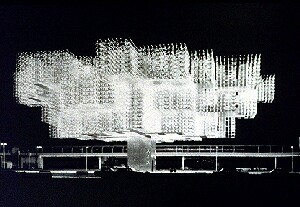|
1 |
 Copyright: |
|
1 |
 Copyright: |
The project to make EXPO '70 a symbol for an ideal city of the future was apparent in the lines of the plans produced by Kenzo Tange. Unlike previous expositions in Paris, London and New York ,where existing city structures had to be taken into consideration and incorporated, in Osaka the organisers chose a site out of town with a hilly landscape to provide a - for the most part - open area in which to present spatial and architectural ideas. The site was divided into two zones by Osaka's new ring motorway and the railway line.
The smaller southern section provided room for the "Expoland" theme park and the administration building, while the north provided room for a large Japanese Garden and the pavilions, which were accessed by a monorail system. Kenzo Tange connected the two zones with an approximately one kilometre long and 150 metre wide Symbolic Area. Tange's proposal for an ideal urban structure comprised a tree in full blossom, whereby this central track represented the trunk. Spreading out from this were the minor access roads, the branches, and on a second level air-conditioned moving pathways for pedestrians which carried people to seven plazas named after the days of the week.
The pavilions - with the smaller buildings grouped around an artificial lake stretching across to the Symbolic Area and the larger ones set on hills along the margins of the ground - represented the flowers of the symbolic tree. The stringency of this concept - which was reflected in a very understated colour scheme and clear designs - was somewhat disharmoniously superimposed by the many very colourful and loud pavilion "blossoms". But, none-the-less, this fitted in with both the theme of the exhibition as well as with Tange's spatial concept. Unlike Montreal, where the strict application of the rules tended to confine and restrict the realisation of ideas by the individual countries, the aspiration was to encourage individual and diverse ideas by the participants: bringing them together formally and symbolically within a clear fundamental structure to form a unified whole.
| Year: 1970 | City: Osaka | Country: Japan |
| Duration: 5 March - 13 September 1970 | ||